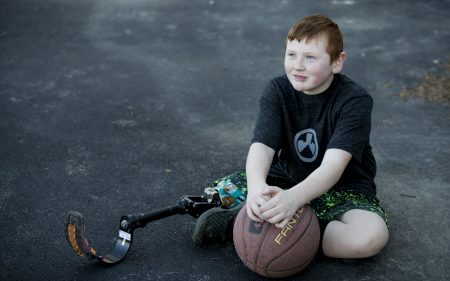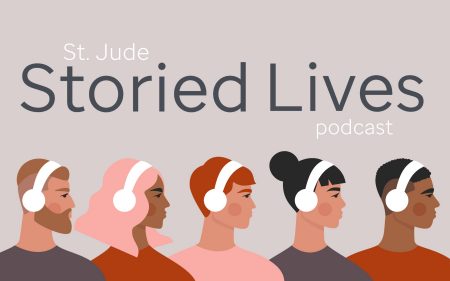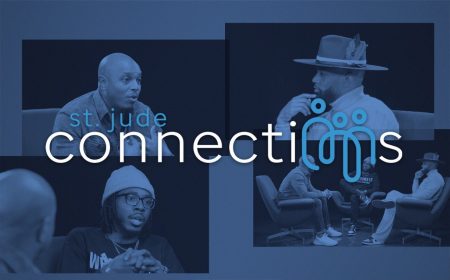
Nick's Song: Heart and Hard Truths
He was a quiet kid with a gift for basketball — and a cancer diagnosis. Now, he’s a teenager transformed, rapping his St. Jude story with brave songs from a bared soul.

January 17, 2019 • 8 min
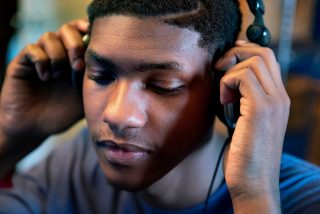
Just me and my beanie
Let the story begin
Chemo was taking my hair
Like a blow in the wind
Nick battled cancer and lived to rap about it — survivor songs full of rhyme and raw emotion, a soundtrack to a teenager’s two-and-a-half year journey through darkness to light.
Performing as St. Nick, and on his recently released album, he raps about facemasks and sanitizers, fear and recovery.
He raps about the beanie that once covered his bald head but worn now only “when it’s cold / not when I’m hurting.”
And he raps about the place that saved his life: St. Jude Children’s Research Hospital.
I do this for The Jude
Fight after fight
They’re saving lives at The Jude
‘I wasn’t the same Nick’
“First it was fatigue,” he said, “which I tried to tough through, because I thought it was just because some of the snacks I was eating.”
Then dark circles began forming around his eyes. Then came knots in his stomach, knots so hard that friends thought he’d been working out on the sly. “No,” he said. “I don’t know what it is. I take the compliment, but I don’t know where these abs came from.”
It was the summer of 2014 and Nick was beginning to look like an elite basketball prospect. Already 6-foot-6 entering high school, he had game and good genes — his father, Paris, was one of nation’s most-heralded recruits of the mid-1990s.
It was shaping up as “a breakout summer for Nicholas,” Paris said. “Because up to that point, I was the only one who had coached him. He was getting better and better. That summer is when I decided to allow him to play with other competitive teams, and Nicholas thrived. He put up really good numbers. He put himself in position to be recruited.”
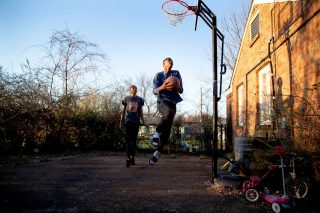
Nick plays basketball outside his home with his cousin, Antonio. Groomed for basketball since he was young, Nick was beginning to look like a break-out high school recruit before he was diagnosed with ALL in 2014.
But as the summer wore on, as Nick traveled the country for tournaments and an elite camp affiliated with NBA star Chris Paul, something was happening.
He couldn’t eat. His hips ached. He lagged behind teammates in drills and his game performances were wildly inconsistent.
He played on, because that’s what athletes are taught. That, and he was a quiet kid, not given to complaint.
“But you could tell when you looked at me,” he said, “that I wasn’t the same Nick that I was at the beginning of the summer.”
His parents grasped for explanations. When Nick’s coach called to say he was barely eating on the road, Tangela, Nick’s mom, thought maybe he just missed her cooking. But it was no better once he was back home.
“I was fixing his favorite dishes and he would usually eat seconds, but (now) he was eating just enough,” she said. “He would just say he was full, and didn’t know how to put his symptoms into words.”
Paris, a 6-foot-8 former player at the University of Memphis and Arkansas State, sought a basketball explanation. After all, this was the summer the father set the son free, to make his own name among the young phenoms. Heady stuff for a teenager who had yet to play a tick of high school ball.
“When we started to notice the change was after he came back from a trip with a team that he was playing with, out of Arkansas,” Paris said. “He came home to play for me in some local events, and we noticed that the energy level wasn’t there. He wasn’t hustling the way that he normally did. So of course we thought it was him kind of getting the big head.”
The summer slog continued. Symptoms mounted — nausea, dizziness, bloating. “My body was slowly starting to break down,” Nick said. “And through all this I was still playing basketball. I was still trying to play.”
He knew something was wrong. They all did. They just didn’t know it had a name. Cancer was unthinkable. Who wants to think the unthinkable?
“I knew how to push his buttons, and that wasn’t working,” Paris said. “I didn’t know if it was him just really going off and becoming a teenager …
“Because I didn’t think he was sick. But I did know something was going on. It took his mom stepping in and kind of telling me, like, ‘You have to realize, Nicholas is not a complainer.’ Because he started to complain.
“When she said that, it made a lot of sense. That’s when she first scheduled that appointment.”
On Aug. 19, two weeks after school started, Nick’s pediatrician ran a complete blood count, and then another. Then they waited — it was Nick and Tangela and her parents. They waited an hour, two. Then the doctor called Tangela and her mother out of the room, to deliver the diagnosis, and to say St. Jude was expecting them that day.
Tangela remembers when they first arrived at St. Jude, awaiting confirmation of the pediatrician’s diagnosis. She remembers Nick’s question.
“We were sitting there, and he goes, ‘This is the hospital for cancer, isn’t it?’ ”
‘She lit the flame’
Now I was barely 14
when my life flipped around
Was making my name
in this hooping game around the town
He’d gone from a teenage version of having it all, to having acute lymphoblastic leukemia (ALL), the most common form of childhood cancer.
From a dream of playing in the NBA, to facing a foe that didn’t play games.
From cheers, to stares.
So the quiet kid wrote to cope. It was his mother’s idea.
“For me it was like, write every day,” Tangela said. “I don’t care if today was hellish, you know. Or today was awesome. Or, ‘I felt like crap.’
“Even if you don’t talk about it, write about it. … It’ll turn into a story.”
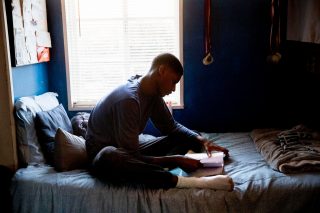
Urged by his mother, Nick turned to writing to cope during his cancer treatment. He recorded his feelings and experiences in a journal titled "Nick's Story," turning his life into rap lyrics about the realities of being a teen with cancer.
Nick took naturally to writing. Like a lot of quiet kids, he had a reflective nature, depths beneath the surface. He kept a journal called “Nick’s Story.” “I had all these emotions that were bottled up,” he said, “and I needed a way to get them out.”
In one entry, he wrote:
My body was falling apart and I didn’t know how to express it so I pushed through. It wasn’t until we started to get on planes that the effects really hit me. My brother and I took a trip to Las Vegas for a tournament and I’ll never know how I made it. It was extremely hot and my stomach hurt the whole trip. My teammates constantly asked, was I OK and was I feeling fine and were very supportive. So I toughed it out …
It turned into a story, as Tangela said it would. It was a story about feeling scarred and scared. A story about “flipping out,” Nick said, because it’s Tuesday night and your mom just reminded you of something you couldn’t forget if you wanted: Wednesday’s chemo day.
“Because I knew what it was going to do to me,” he said, “knew how it was going to break me down.”
Nick’s St. Jude story is a bravely told tale of a bared soul. A story with big scary words, like Methotrexate, a chemotherapy drug whose side effects include hair loss. A story about those times when the cure seems crueler than the disease.
“For babies and younger children, it’s a thing of, maybe they won’t remember that part,” Tangela said. “It’s so different when you have a teenager going through it. Because not only are they going to remember everything, they understand what they’re going through.”
But if teenage cancer is a curse, there are blessings, too. St. Jude has child life specialists who work solely with teens. There’s a Teen Room with video game systems — no adults allowed. There’s a private social networking site just for teens, a Teen Art Show, a Teen Formal.
And there are — blessing beyond blessings — other teenagers, fighting the same fights, facing the same fears.
For Nick, there was Hannah, “so vibrant, full of energy all the time.”
“She lit the flame,” he said. “She inspired me to do a song for the Teen Art Show at St. Jude. That’s a really big thing, because that’s the day where you get to showcase your art, showcase what you’re good at.
“She inspired me to do a rap.”
By “inspired,” he means “insisted.” That was Hannah. After hearing Nick freestyle over rap beats at a party she’d invited him to at Ronald McDonald House, Hannah pushed him to pursue his music.
“The next day, I was going to St. Jude to get fitted for my tux for the St. Jude prom,” Nick said. “They asked me was I going to do anything for the Teen Art Show. I said, ‘I don’t know, I don’t know.’
“Hannah came in there and said, ‘He’s going to rap.’ ”
‘You’re not the only one’
Watch your back / he might touch you
Watch your back / he might bump you
Watch your back / he might hug you
So he rapped. And, in time, the quiet kid with the reflective nature gave way to an alter ego named St. Nick, a born showman who recently brought a ballroom filled with 700 people, most of them St. Jude volunteers from across the country, to their feet with his rat-a-tat rhymes.
“I realized after going through what I went through that life’s too short to be like that,” he said of his shy, pre-cancer self. “You have plenty of time to be by yourself nowadays — go mingle with people. Have fun. Sing a couple songs.”
So he sings to heal.
He sings to spread the word about a hometown hospital that has helped increase survival rates for ALL from 4 percent before opening in 1962 to 94 percent today.
He sings to tell the world how it feels to be on the sick side of the mask.
“You think because I’ve got the mask, I’m the one who could get you sick,” he said, remembering the days that inspired his song “Tag You’re It.” “But in reality, my ANC (Absolute Neutrophil Count, a reflection of the body’s ability to fight infections) is so low, if you touch me, you’re going to get me sick. I could die.
“So it was like a game of tag. You think I’m trying to get you, but I’m trying to stay away from you.”
Tangela remembers one particular day. She and Nick were taking his little brother to school. Nick’s ANC had plummeted.
“He got out of the car, and we were about to walk the baby boy in, and I was like, ‘Get your mask.’ He was like, ‘Aw, I don’t really want to wear it.’ I’m like, ‘You do really want to wear it.’
“I could tell, when people were walking by, they were kind of looking at him. When we got back to the car, I told him, I said, ‘I don’t care what people think, or what they say, how they look at you. They’re more of a threat to you than you are to them. You have to realize that.’ ”
Nick didn’t say anything that day. But later, as journal entries became the raw material for rap lyrics, he wrote “Tag You’re It,” a song both fierce and poignant.
“To hear him express it in ‘Tag,’ ” Tangela said. “ ‘Watch your back / he might touch you’ … You know what I mean? That’s how he really felt. That was his truth.
“That one actually brought tears to my eyes.”
“Tag You’re It” has moments of true anger (“I’m not even hungry / I can’t even eat / This for all the folks / that quit on me”). But there also are shout-outs to fellow patients like Hannah, “who went on home to glory.”
In the end, it’s a song about coming through cancer, stronger than before — not just healed but transformed: “Yeah, I’m the living proof / St. Nick is the truth.”
In “I Do This 4 The Jude,” Nick is on a first-name basis, one saint to another, with the place that saved him. It’s a celebration song, a survivor’s anthem — and crowds love it when he throws dollars in the air at the lines “Stayed at The Jude for a bit / and didn’t have to pay a cent.”
“Beanie” is a song about losing your hair — and your sense of self. It’s a song about wanting to vanish.
Hide me from the people, please
Hide me from myself, please
“Every time I heard a laugh or something, I felt like they were laughing at me,” he said. “I didn’t really have anybody. So it was like, me and my beanie.”
What better friend, after all, than one that can help with that whole vanishing thing. Bald head? Take that.
“For us, him losing his hair was a really, really tough time,” Tangela said. “I think that’s kind of the time where it solidifies, we’re now a cancer family. … You know what I mean? Everybody knows now.”
“Beanie” is also a song about getting your life back.
Now the story continues
and my life is heading up
No more sanitizers, face visors
and separate cups
Nick is nearly two years removed from treatment, and a senior in high school. His ambition hasn’t dimmed; he’s become a double-threat, training for a basketball comeback and releasing an album of songs about his St. Jude story, titled “14” — because he was diagnosed in 2014, at age 14, and 14 was his uniform number. A portion of the proceeds will benefit St. Jude.
Asked what he’ll be doing in five years, he paused to consider the delicious possibilities.
“Have on a Memphis Grizzlies jersey,” he said, in a nod to the hometown NBA team, “and have the No. 1 album in the country.”
That’s life now for the formerly quiet kid who survived cancer to become a deeper, bolder version of his old self. Now anything’s possible. That’s the ultimate message of his songs, for anyone who is where he has been.
“You’re not the only one,” Nick said. “I’ve been through it. I’m going to put it out there, so you know I’ve been through it.”





